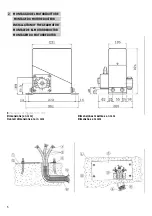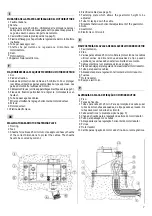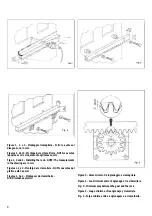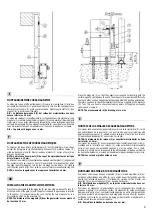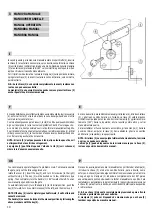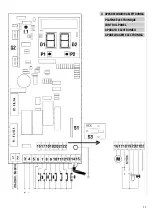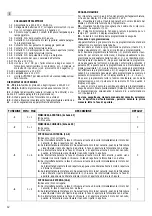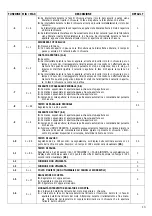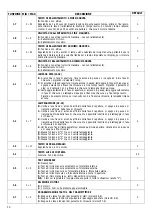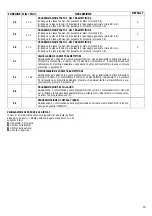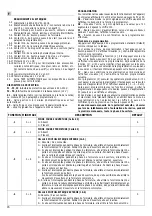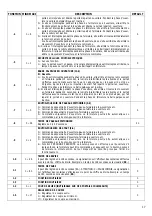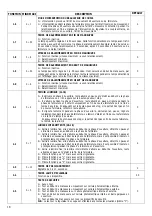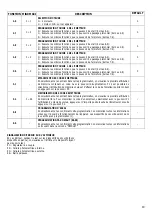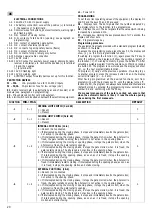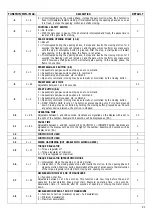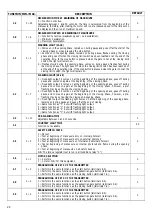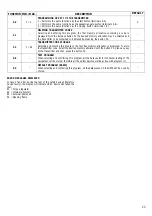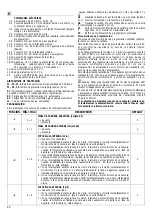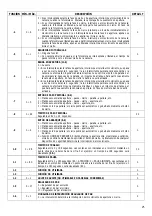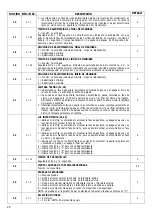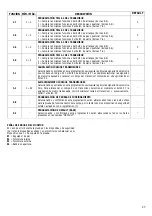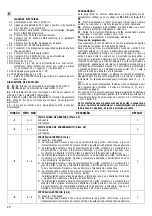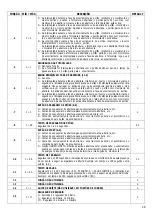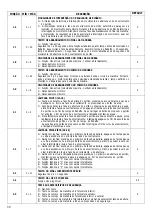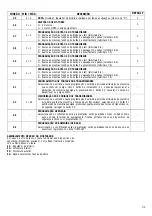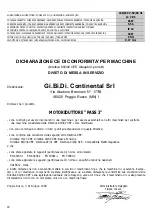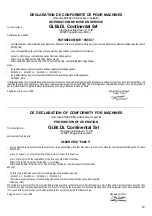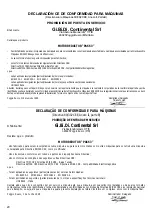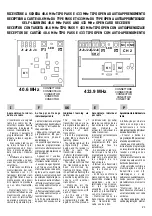
20
UK
1-2
3-4
5-6
7-6
8-6
9-6
10-6
11-6
12-6
13-6
14-15
16-17
18-19
20-18
21-18
22
PROTECTION DEVICES
F1 – F3A
15A protection fuse for 220-230V inputs
F2 – F6,3A
3A protection fuse for low voltage (12V)
S1
- Radio receiver card (see instructions at end of booklet) or RF
module (see paragraph on programming).
S2
– Mini-photocell control card with autotest.
S3
– Limit switch card inserted underneath the electronic equipment.
ELECTRICAL CONNECTIONS
220-230V, 50-60 Hz power supply
12V battery connection; connect the positive (+) to terminal
3, the negative (-) to terminal 4.
Common wires for buttons, photocell contacts, warning light
and flashing light.
N.O. contact of closing button
N.O. contact of start button (opening; see paragraph on
programming)
N.O. contact of pedestrian gate button
N.C. contact of external photocell
N.C. contact of opening safety device (frame)
N.C. contact of internal photocell
N.C. contact of stop or emergency button
Antenna coaxial cable connection
12V DC motor
12V DC output for auxiliary power supply: photocells, radio
receiver in container, etc. Connect the positive (+) to terminal
18 and the negative
(-) to terminal 19.
12V DC flashing light
12V DC warning light
AUTOTEST output for safety devices set up for this function.
L1
– Power LED
PROGRAMMING
To set the correct operating values of the equipment, the display D1
and D2 and the keys P1 and P2 are used.
D1
– Displays tens. The dot signals that the number indicated by
the display refers to the function to be programmed.
D2
– Displays the unit. The dot signals that the value which is being
increased has exceeded 100.
P1
– Increase key. Holding the key pressed down for 7 seconds, the
display will show zero.
P2
– Program storage key.
Programming procedure
The equipment is already provided with a standard program (default)
as shown in the table.
To access the programming menu press the key P2, the display will
show (.1), i.e. the first programmable function.
If wishing to program the function (.1), again press the P2 key to
enter the submenu; the display will show the existing program of
the function (.1). If wishing to modify it, press the button P1. After
selecting a suitable program from the submenu, confirm by pressing
the button P2. The program is now stored and the display will show
(.2), i.e. the next programmable function.
To program (.2) carry out the previous operations. If wishing to go
to another program, press the increase button P1 and the display
will scroll forward (.3 - .4 -.5 etc.).
After having programmed all the desired functions, exit from
programming with the increase key P1 until the display turns off.
In case of error, the program can always be cancelled and the standard
(default) stored by entering the programming menu, selecting the
number 9.9 and confirming with the P2 key.
If a manual manoeuvre of the gate is carried out, ensure that
when the automatic device is reset, it runs the whole opening
phase during the first manoeuvre.
DESCRIPTION
OPENING LIMIT SWITCH (Card S3)
0 = Absent
1 = Present
CLOSING LIMIT SWITCH (Card S3)
0 = Absent
1 = Present
INTERNAL PHOTOCELL (12-6)
0 = Absent / not connected
1 = If intercepted during the closing phase, it stops and immediately inverts the gate motion;
not active in the opening phase.
2 = If intercepted during the closing phase, it stops the gate motion; when the photocell is
freed, the gate restarts opening; the photocell is not active in the opening phase.
3 = If intercepted during the closing or opening phase, it stops the gate motion; when the
photocell is freed, the gate restarts opening.
4 = If intercepted during the closing phase, it stops the gate motion; when it is freed, the
gate restarts closing. The photocell is not active in the opening phase.
5 = If intercepted during the closing phase, it stops and immediately inverts the gate motion.
If intercepted during the opening phase, as soon as it is freed, it stops the opening
motion and starts closing.
6 = If intercepted during the closing phase, it stops the gate motion; when the photocell is
freed it immediately restarts closing. If intercepted during the opening phase, as soon as
it is freed, it stops the opening motion and starts closing.
EXTERNAL PHOTOCELL (10-6)
0 = Absent / not connected
1 = If intercepted during the closing phase, it stops and immediately inverts the gate motion;
not active in the opening phase.
2 = If intercepted during the closing phase, it stops the gate motion; when the photocell is
freed, the gate restarts opening; the photocell is not active in the opening phase.
3 = If intercepted during the closing or opening phase, it stops the gate motion; when the
photocell is freed, the gate restarts opening.
4 = If intercepted during the closing phase, it stops the gate motion; when it is freed, the
gate restarts closing. The photocell is not active in the opening phase.
5 = If intercepted during the closing phase, it stops and immediately inverts the gate motion.
If intercepted during the opening phase, as soon as it is freed, it stops the opening
motion and starts closing.
FUNCTION
.1
.2
.3
.4
MIN.
÷
MAX.
0
÷
1
0
÷
1
0
÷
6
0
÷
6
DEFAULT
0
0
0
0

